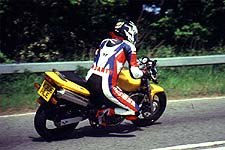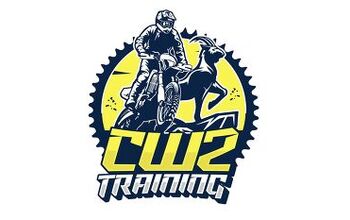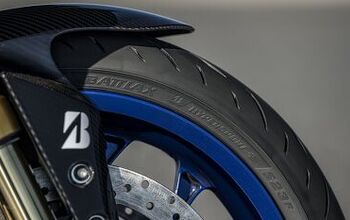Honda Hornet 2000 - Motorcycle.com
Lincolnshire, June 26, 2000 -- By looking at the following recipe, see if you can guess what we're cooking up today:
Take a class-leading lightweight super-sports bike, keep the engine and brakes but remove all the body work. Cobble together a new chassis and add the wheels from a top hyper-sports machine and what do you reckon the resulting dish will be? It's a standard though some call it a roadster. Call it what you will or call it a Hornet, as Honda prefers you do.
It might seem like a strange recipe to use when you want to build a bike to slot neatly into the ever-growing roadster market but, nonetheless, it's one that works well.
Just like its cousin, the CBR600F4, the Hornet has proved a hit in Britain and it's easy to see why. Here's a bike with instant mass-market appeal.
Honda was very shrewd; when they made this bike, they managed to launch a brand new motorcycle that had enough components from one of their longest running and most successful models to ensure that the bike buyer wouldn't be concerned about becoming a prototype guinea pig. The use of the old model CBR600 powerplant - an engine that's well proven on both road and track - ensures instant piece of mind for the user.
Honda was also clever with the styling. Or perhaps brave is the correct word? The ultra-up-swept exhaust pipe isn't everyone's cup of carbon monoxide but it is distinctive. It ensures that the Hornet will not just blend in against a background of Bandits and Zephyrs. There's no fairing on the standard model, just a traditional round head lamp (remember those?) and a pair of clocks complete with the regulation chrome bodies, just like an early Z1 Kawasaki.
For this season Honda added a half fairing on the "S" model which is sold alongside the standard Hornet. The jury is out as far as the styling of the "S" is concerned and the naked Hornet still sells very well, seemingly untroubled by the presence of its flashier brother. Honda has also increased the wheelbase by five mm to 1425 mm and increased the diameter of the front wheel to 17 inches. This has given the Hornet more stability which is nice since many testers complained that the original version was too twitchy.
"The Hornet is a budget bike and has been built down to a price, rather than up to a specification."
The test model that Honda supplied to Motorcycle Online was almost brand new, barely run-in and all still very shiny.
The finish looked good but I have heard complaints about finish from another magazine tester who rode a bike supplied from a dealership. That bike, which had obviously been outside more and had not been prepared to quite the same (extremely high) standard as our test bike, was already sporting signs of corrosion.
The Hornet is a budget bike and has been built down to a price, rather than up to a specification. It might take a bit of tender loving care to keep it all bright and shipshape, especially if you intend to make it your ride-to-work hack. Nevertheless, our test bike looked great in bright yellow. It may be a roadster but there's a subtle look of aggression about it which is accented by the sporty tail-piece and the high-level silencer.
"The Hornet is an easy bike to ride and it's a doddle to throw into a bend."
Although fitted with a former CBR600 motor that has been re-tuned for extra torque, the Hornet is still no grunt-master. It's a four-cylinder four-stroke with only 600 cc of motive power. It's not a V-twin and even the slower SV650 from Suzuki actually feels like it has more poke. The truth of the matter is the Hornet will out-perform the SV650 in a straight line but it does so without feeling quite as exciting. And the Honda pilot will have to use all the six-speeds supplied in the sweet little gearbox to keep the Hornet buzzing. Vibration is typical of the genre; four-cylinder bikes do vibrate but it isn't usually that intrusive. The Hornet is no different as you can tell it's running, but it won't loosen fillings.
I passed the bike on to Graham, my neighbor and faithful gofer, for a ride. Graham has not been effected by the, "I'm a Superstar road tester," syndrome and is a good barometer of how a bike feels to a guy who still works for his living.
Graham has owned a CBR600F in the past and his first comment was, "I feel like I'm back with an old friend!" Indeed, the CB600 is a lot like the bike it's derived from, despite the slight shifting of the ponies down the rev-range. It still needs to be stirred quite hard to get the best out of it but it delivers the goods in a fuss-free manner which is instantly accessible to riders of all levels of experience.
The Hornet is an easy bike to ride and it's a doddle to throw into a bend, especially since it's endowed with plenty of leverage from the real handlebars. You know, the type made of a single piece of chromed tube? The upright riding position combined with the sporty geometry provides a quick steering bike that still verges on the twitchy side when pushed hard through bumpy corners. At speed it's a little nervous, though it's more of a spring thing than a geometry problem since the soft front end means the bike will move around a tad. Fear not, however, since the upright riding position means your head will be ripped off by the wind long before the bars twitch out of your hands in a speed wobble.
This isn't a bike for 120 mph motorway blasts, France-and-back-in-16-hours style. It will tour; the riding position is plenty comfortable enough for long jaunts as is the wide saddle. The tiny petrol capacity - only 16 litres - will be a pain for the adventurous cross-continent touring types, though. More to the point, this is a bike for good old-fashioned backroad fun, or simple ride-to-work chores. It's a genuine all-rounder.
The willing engine and eager handling are backed up with good brakes. They are the same as you'll see on older CBR600Fs and they are adequate without being stunning. If you ride the Hornet alongside the latest version of the CBR600F4, you might wish for the CBR's better braking and suspension set-up. But, ridden in isolation, the Hornet's stoppers perform well enough. The front end gets a bit squirrelly if you insist on using the brakes very hard, especially deep into a corner; it's short on damping and long on dive. The rear shock is more competent, with better damping and springing. But if you really want class-leading handling then you should choose the CBR, not the Hornet.
The Hornet is a friendly bike. The lack of body-plastic means the inevitable parking lot spills won't hammer the pocket-plastic so hard. The low seat height, upright handlebars and relatively low weight will mean that the spills will happen less often, even if your legs aren't as long as most bike designers think they should be. No surprise, then, that the Hornet has proved popular with the female population.
Complaints are few. I don't like the switch gear and found the indicator switch a long stretch even for my giant thumb. It needs to be a little lower on the switch module. The short front mudguard may be stylish but it means the naked engine is getting doused by water, mud and stones, especially if you ride the bike in Britain. That'll make short work of those down-pipes.
"Honda. It stands for reliability, quality and excellent after-sales support."
The petrol tank's lack of capacity almost caught me out during one jaunt. The bike ran onto reserve, but I decided to try to make it for 20 more miles to use my favorite local supermarket fuel point, rather than the high-priced one that came up first. It proved a mistake as the three liter reserve was almost exhausted by the time I rode into the chosen petrol station. The bike coughed and spluttered onto the fore-court with the tank bone dry and the motor running on what was left in the float bowls. The Hornet may have smaller carbs than the CBR (34mm compared to 36mm) but it still likes to guzzle gas if ridden very hard.
The Hornet has followed the CBR600F into sales success. It hasn't set the market aflame nor has it dominated the charts like the CBR did. But this isn't due to any problem with the bike; it's more to do with the depth of the competition which includes cheaper bikes like the SV650 and sportier bikes like Yamaha's excellent Fazer.
The Hornet does have a number of advantages over the competition, though. The first being the name on the tank: Honda. It stands for reliability, quality and excellent after-sales support. The second is that, unlike the SV650, it's based on a well-proven engine, although the Thundercat-derived Fazer can make this boast too. When it comes to buying the choice is down to the individual, it's impossible to say which bike suits your taste best, that choice has to be down to you. But it is possible to say that the Hornet recipe will suit most people's tastes most of the time. And who can ask for much more in a bike than that?
CB600F Hornet Specifications
Engine: Liquid-cooled 4-stroke,16-valve DOHC inline-4Bore x Stroke: 65 x 45.2mmDisplacement: 599ccCompression Ratio: 12:1Carburetors: Four 34mm downdraftflat-slide CV-typeMax. Power Output : [email protected],750rpmMax. Torque: 45lb/[email protected],250rpmIgnition: Computer-controlled digitaltransistorized with electronic advanceStarter: ElectricTransmission: 6-speedFinal Drive: ‘O'-ring sealed chainDimensions: H 2,095 x 740 x 1,065mmWheelbase: 1,425mmSeat Height: 790mmGround Clearance: 140mmFuel Capacity: 16 liters (includingthree-litre reserve)Wheels Front: 17 x MT3.50 hollow-section triple-spoke cast aluminumRear: 17 x MT5.50 hollow-sectiontriple-spoke cast aluminumTyres: Front 120/70 ZR17Rear 180/55 ZR17Suspension Front: 41mm telescopicfork, 120mm axle travelRear: Monoshock damper with 7-stepadjustable pre-load, 128mm axle travelBrakes Front: 296 x 4.5mm dual hydraulicdisc with dual-piston calipers fitted withsintered metal pads and gripping floating steel rotorsRear: 220 x 5mm hydraulic disc withsingle-piston caliper and sintered metal padsDry Weight: 176kg
More by Glenn LeSanto

































Comments
Join the conversation